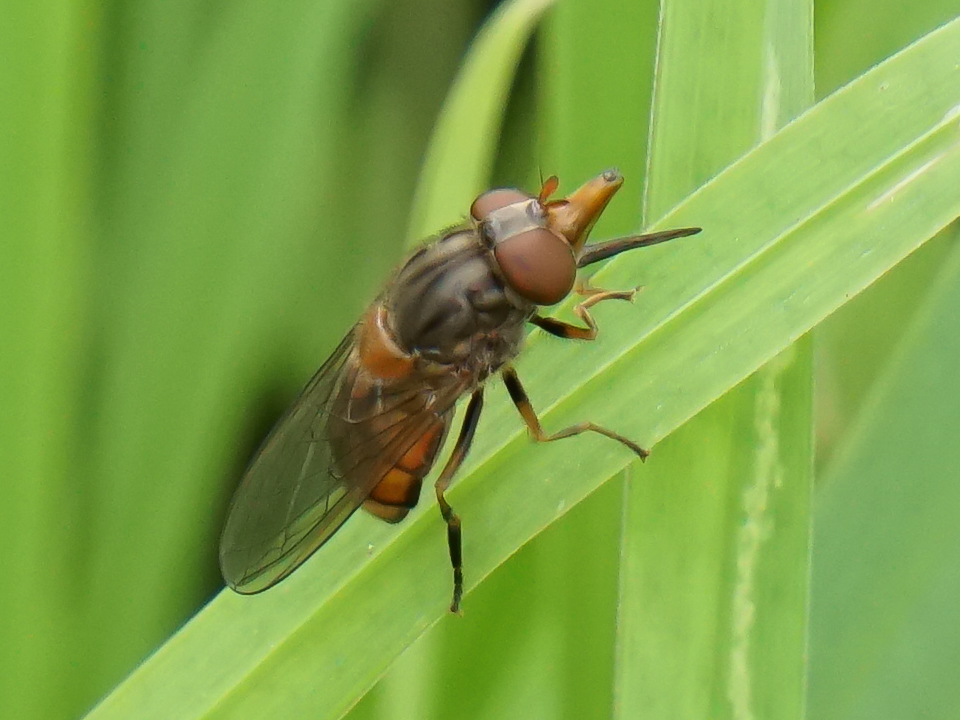
Paul writes: Rhingia campestris is one of the most recognisable hoverflies, it’s often known as the Heineken hoverfly and was the subject of a very early post of mine on Mark’s Blog. I described it then as common and widespread throughout the UK. In only 2 years things have possibly changed dramatically. The drought of 2018 seriously affected hoverflies, at least in the short term. Long dry periods curtail the nectar producing properties of flowers, which are the primary energy source of many hoverflies. This lack of food leads to reduced breeding productivity. Hoverfly sightings are widely recorded throughout the UK so 2019 records are being scrutinised carefully. It appears that records of Rhingia campestris have drastically reduced in most of southern England and Wales. This mirrors my own experience in North Yorkshire. The species has two main broods, May and August. In spring 2018 they were locally common in the fields around my house then in August there was a huge drop in numbers with only a few sightings. I was relieved in spring 2019 to still see them around but sighting were much reduced. I’ve been waiting anxiously this August to see if they appear and found this one a few days ago at a site several miles away. I still haven’t seen one at home. It shows how fragile the breeding success of some species can be but hopefully numbers can bounce back, in the absence of more extreme weather. It would be nice to write another blog in five years time and still describe the species as common and widespread. One piece of good news is that in Scotland the species is still doing OK.
[registration_form]
Interesting. By comparison I have been looking up the hoverfly Hornet mimic. I don’t remember noticing it before but this year it is quite common? One day I saw four on a buddleia in the garden. reading about it it first appeared as a migrant from 1940s in Kent and the south now it is apparently spreading North.
Saw LOTS of hornet hoverflies on the Isle of Wight last week. As the larvae rely on the nests of social wasps (I believe) perhaps their numbers rely on the amount wasp nests available? Is it a good year for wasps too?
A piece of good news is that I’ve just seen a Rhingia campestris in my garden.
Paul – hooray!
I had a bit of an obsession with this hoverfly, and like to think some of my photos of it are still the best I’ve ever seen, including literally getting inside the flower with it when feeding. It was their mouthparts that fascinated me, and how when unpacked from under that snout, it was a huge and complex instrument, for both drinking nectar from deep throated plants, to collecting their pollen.
I’ve seen big declines in lots of insects in the last 12 years or so. Especially hoverflies. I set out to photograph hoverflies after learning where to find them in numbers, and how to get in close to them. Then suddenly I could no longer find the numbers I used to be able to. To get creative intimate close-ups you need high densities, because most attempts to get that close, fail and the hoverfly just flies off. You need a lot, to find an individual that will cooperate with you, feeding away whilst you get in close for the photos.
When I used to live in Lancashire I used to know where to find lots of Rhingia campestris. Patches of Bugle (Ajuga reptans), and Dandelions. However, since moving to Shropshire I’ve never seen as many of them. I do see them regularly just not in numbers, a few here, a few there. I noticed some today on my butterfly transect, on Heather of all things. Not something I ever thought of as typical Rhingia campestris forage. So I’m not in much of a position to judge their current population. But either I’ve lost my touch, or a lot of hoverfly numbers are down this year. Odonata numbers have been particularly low this year, as a lot of pools dried up last year.
The difficulty with judging insect population declines is that you can only really see them with hindsight of quite a few years. They’ve always had good years, bad years, with numbers yo-yoing over several year periods. But you only realise there’s been a genuine decline when the population doesn’t bounce back, and you realise it’s many years since you saw the numbers you used to get in the past. Often it’s only when I look back through my photography files, and it triggers my memories, 5, 10, 20 or more years ago, that I realise how certain insect populations have declined, and how long it is since I saw the numbers in the past.